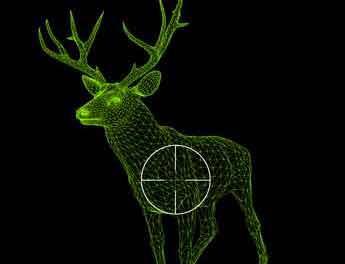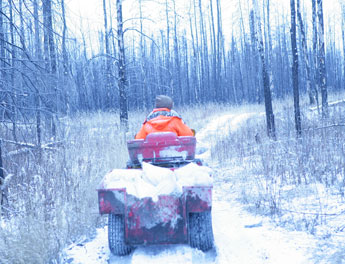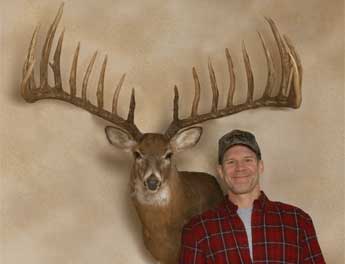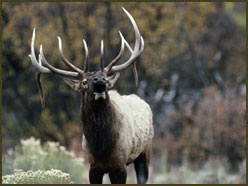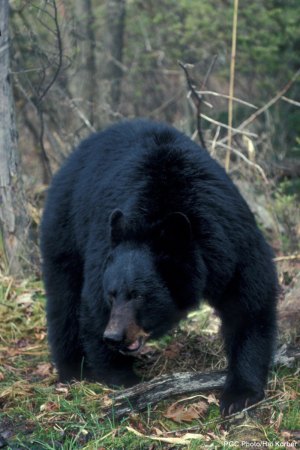The buck was big. Linebacker body, weight-lifter neck, and the wide, low, heavy rack of a mature woodland whitetail. While he wouldn’t make “The Book,” he’d count as a trophy in any living room. He absolutely dwarfed the seven-pointer lying at my feet. And all that I could do was watch him ghost away through the hardwoods. Maybe next year…
This was the sixth buck I’d seen since dawn, in a region where most hunters are lucky to see anything wearing horns in a season. Five of the bucks were in a bachelor group that included spikes, forkhorns and the tall-but-spindly seven-pointer I downed with a single 120-grain bullet launched from my 7×30 Waters T/C Contender Carbine. The big guy came along later.
Before dawn, I’d looked far down into the valley and watched a parade of headlights winking though leafless woods along the dirt roads that bordered this chunk of national forest. In the silence, I could hear truck doors slam from miles away. Those other guys didn’t know it, but they were going to drive deer to me.
Feeling the Pressure
I’d eased in to this remote spot the afternoon before, when all was quiet. My camp–sleeping bag and pad, tiny tent and a few essentials–was on a flat spot in a dense thicket with a trickling spring a few feet away.
Excitement woke me early. I brewed coffee on the small camp stove next to me before rolling out of my sleeping bag. I ate a couple of granola bars, dressed, grabbed my rifle and eased my way quietly by the light of the waning moon to a saddle between peaks.
I tucked into a pre-scouted crevice that afforded me a clear view across most of the saddle, where I expected the deer to follow the path of greatest security and least resistance. Below me were oak groves, brushy clear-cuts and, farther down, small fields and roads. Behind me was a square mile of tangled, dark evergreens that no human hunter could quietly penetrate. It was a perfect sanctuary for deer, although one they might not have chosen except for hunting pressure.
As the first hints of dawn crept into the eastern sky, I could visualize the deer, which had been feeding in the fields and oaks all night, being pushed by a small army of hunters moving in from the roads. As the light grew, an occasional flurry of distant shots echoing among the ridges confirmed it. Bucks that were trying lateral or flanking maneuvers around the first hunters encountered were bumping into other hunters. The survivors would turn my way. A half-hour after shooting light, right on schedule, that first trickle of bucks reached the saddle and my season ended–one buck too soon, as it turned out.
Hunter Patterns
If you hunt on open or public land such as national forests, timber company holdings or state game lands and wildlife management areas, the single biggest factor in your hunting success or failure is the one you have least control over: other hunters. Before the firearms season opens, you can pattern the deer to your heart’s content, but on opening morning or any weekend, the presence of other hunters will quickly spoil that pattern for you.
Fortunately, other hunters are patternable, too. Most park in predictable places and follow specific paths such as gated logging roads and hiking trails. On opening day and on most weekends, the influx of hunters will alert every deer in the neighborhood that something is up and start them drifting toward safety at full alert.
Most hunters want to be in the woods well before dawn, and some will actually succeed. Many will take a stand within a half-mile of the road, which is about as far as they want to hike in the dark with a flashlight. Their movements in the dark alert nearby deer; mature bucks that might have stayed in the neighborhood before suddenly are on the move, stealthily easing toward safer havens.
Despite the best-laid plans of some hunters, they won’t get the early start they’d hoped for and will simply blunder into the woods at or after first light. These are the folks who will get the whole deer herd moving toward you if you’ve been smart enough to pre-plan and pre-position your ambush.
Going Solo
Even though it’s a supremely effective hunting tactic, not many hunters are going to put on a pack and head out by themselves for a long night or two in the woods. The majority of hunters are creatures of civilization and habit; the camaraderie of a hunting camp is as important as getting a photo taken standing beside a hanging deer. This tendency works in your favor if you’re already there ahead of other hunters.
Start with a place to hunt. Ideally it will be a chunk of land with thick evergreens, steep rocky hillsides and featureless swamps. There should be just enough distance from roads to make it unattractive to hunters and attractive to deer–half a mile is good, a mile is better. Chances are you’ve already avoided such a spot yourself.
If you don’t already know a suitable spot, ask game wardens, foresters and rangers in the area you want to hunt. Or, get good maps (such as the DeLorme atlases published for all 50 states: 800-561-5105; www.delorme.com), find an area that looks promising and scout it in summer.
Take your minimalist camping gear and stay in the woods a night or two as a run-up to hunting season. You won’t need as much equipment as you might think [see sidebar, left]. Carry enough drinking water and food to last one or, at most, two nights in reasonable comfort. In other words, keep it simple.
Your camping spot should be well hidden and away from trails that deer are likely to travel. Identify ambush spots overlooking likely corridors where the deer will move when pushed. Don’t worry about spooking the deer before the season. Chances are they are used to seeing hikers and foresters. The deer you are really hunting are the ones closer to the road that will head into the backcountry to escape other hunters.
And you’ll be there waiting.
Travel Light
Keep camping gear to a minimum: The focus should be on hunting, not camping.
PACK If you don’t wear a pack while hunting, any frame pack that transfers the bulk of the weight comfortably to your hips will do to get your gear to a temporary campsite. I prefer a Kifaru (shown). These are the very best packs I’ve found for the job. (800-222-6139, www.kifaru.net)
SHELTER In reasonably good weather, a cheap tarp strung between trees works fine. I often use a tiny two-man Coleman Exponent Inyo 2 backpacking tent that weighs 4 pounds. It offers more space for me and my gear than a one-man bivy shelter. (800-835-3278; www.coleman.com)
SLEEPING GEAR A backpacker’s mummy bag will provide the greatest warmth for the least weight. I like Wiggy’s SL; it’s rated to 0 degrees and weighs 4 1/2 pounds. Cabela’s sells the bag for $165 (800-237-4444; www.cabelas.com). Beneath it, a three-quarter-length Therm-a-Rest Ultralite pad from Cascade Designs provides more insulation and comfort. It weighs 18 ounces. (800-531-9531; www.cascadedesigns.com)
STOVE If you can live without morning coffee or tea, you can skip this and take along ready-to-eat grub. Being a coffee drinker, I use a Coleman Xtreme. With fuel and a small pot, the little stove weighs less than 2 pounds. As for utility, a stove is easier and cleaner than a fire built on the spot.
Getting Your Deer Home Killing a deer a mile or more from a road can pose a major problem: How do you get it out? If local regulations allow, I bone out a buck where it falls, then carry the meat, cape and horns or proof of sex all in one backpack load. If a carcass is required for registration, cut the deer in half in front of the hindquarters. Pack out the hindquarters and drag out the front half. Wear hunter-orange clothes.

